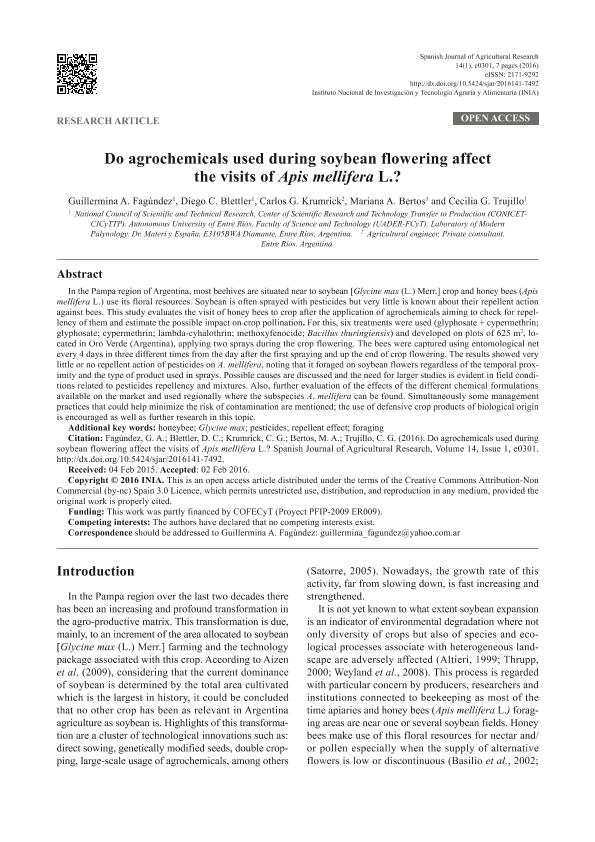Artículo
Do agrochemicals used during soybean flowering affect the visits of Apis mellifera L.?
Fagundez, Guillermina Andrea ; Blettler, Diego César; Krumrick, Carlos G.; Bertos, Mariana de Los Ángeles
; Blettler, Diego César; Krumrick, Carlos G.; Bertos, Mariana de Los Ángeles ; Trujillo, Cecilia Gabriela
; Trujillo, Cecilia Gabriela
 ; Blettler, Diego César; Krumrick, Carlos G.; Bertos, Mariana de Los Ángeles
; Blettler, Diego César; Krumrick, Carlos G.; Bertos, Mariana de Los Ángeles ; Trujillo, Cecilia Gabriela
; Trujillo, Cecilia Gabriela
Fecha de publicación:
03/2016
Editorial:
Spanish National Institute for Agriculture and Food Research and Technology
Revista:
Spanish Journal Of Agricultural Research
ISSN:
1695-971X
Idioma:
Inglés
Tipo de recurso:
Artículo publicado
Clasificación temática:
Resumen
In the Pampa region of Argentina, most beehives are situated near to soybean [Glycine max (L.) Merr.] crop and honey bees (Apis mellifera L.) use its floral resources. Soybean is often sprayed with pesticides but very little is known about their repellent action against bees. This study evaluates the visit of honey bees to crop after the application of agrochemicals aiming to check for repellency of them and estimate the possible impact on crop pollination. For this, six treatments were used (glyphosate + cypermethrin; glyphosate; cypermethrin; lambda-cyhalothrin; methoxyfenocide; Bacillus thuringiensis) and developed on plots of 625 m2, located in Oro Verde (Argentina), applying two sprays during the crop flowering. The bees were captured using entomological net every 4 days in three different times from the day after the first spraying and up the end of crop flowering. The results showed very little or no repellent action of pesticides on A. mellifera, noting that it foraged on soybean flowers regardless of the temporal proximity and the type of product used in sprays. Possible causes are discussed and the need for larger studies is evident in field conditions related to pesticides repellency and mixtures. Also, further evaluation of the effects of the different chemical formulations available on the market and used regionally where the subspecies A. mellifera can be found. Simultaneously some management practices that could help minimize the risk of contamination are mentioned; the use of defensive crop products of biological origin is encouraged as well as further research in this topic.
Palabras clave:
Honey Bee
,
Glycine Max
,
Pesticides
,
Repellent Effect
Archivos asociados
Licencia
Identificadores
Colecciones
Articulos(CICYTTP)
Articulos de CENTRO DE INV.CIENT.Y TRANSFERENCIA TEC A LA PROD
Articulos de CENTRO DE INV.CIENT.Y TRANSFERENCIA TEC A LA PROD
Citación
Fagundez, Guillermina Andrea; Blettler, Diego César; Krumrick, Carlos G.; Bertos, Mariana de Los Ángeles; Trujillo, Cecilia Gabriela; Do agrochemicals used during soybean flowering affect the visits of Apis mellifera L.?
; Spanish National Institute for Agriculture and Food Research and Technology; Spanish Journal Of Agricultural Research; 14; 1; 3-2016; 1-7; e0301
Compartir
Altmétricas



